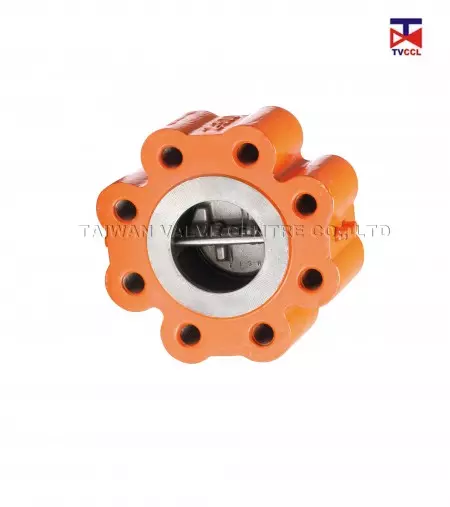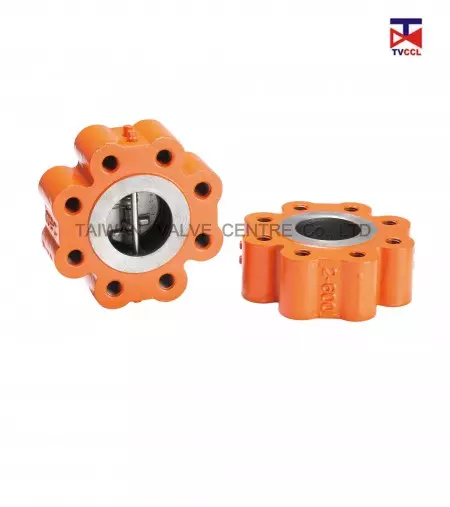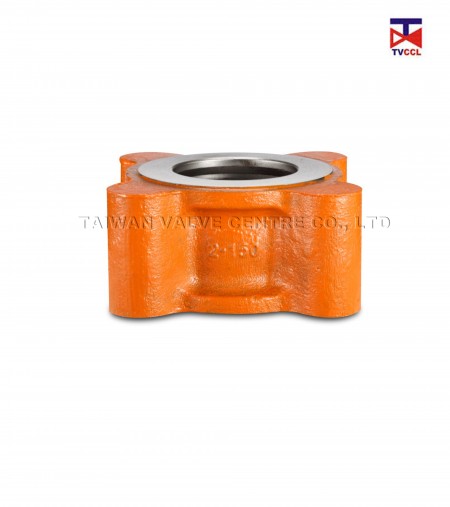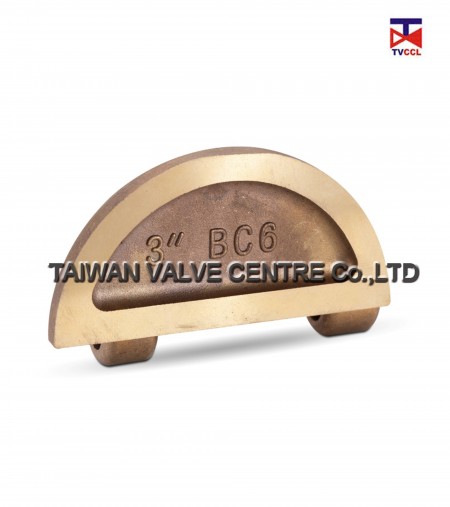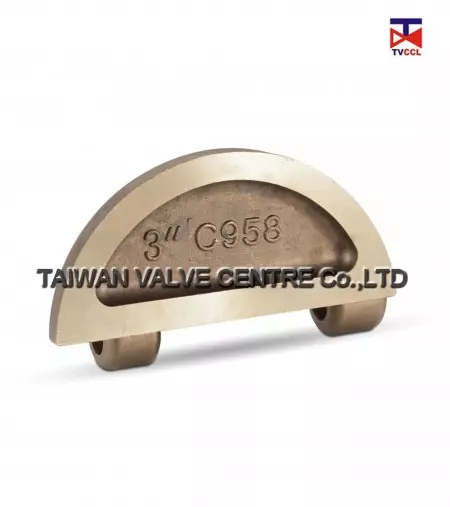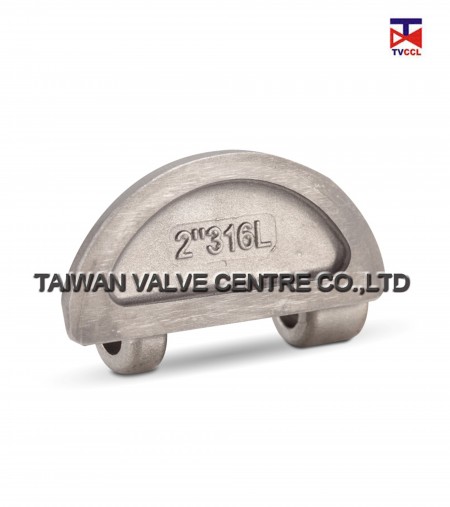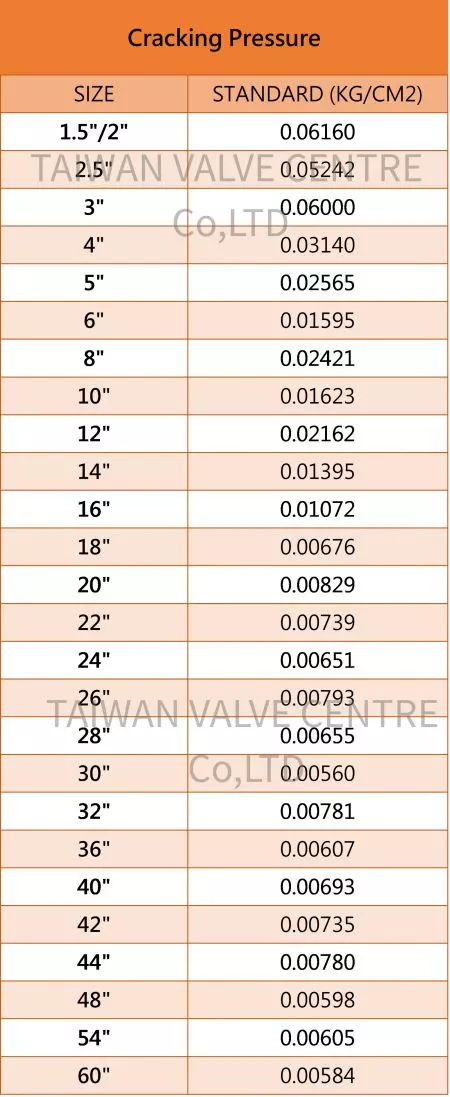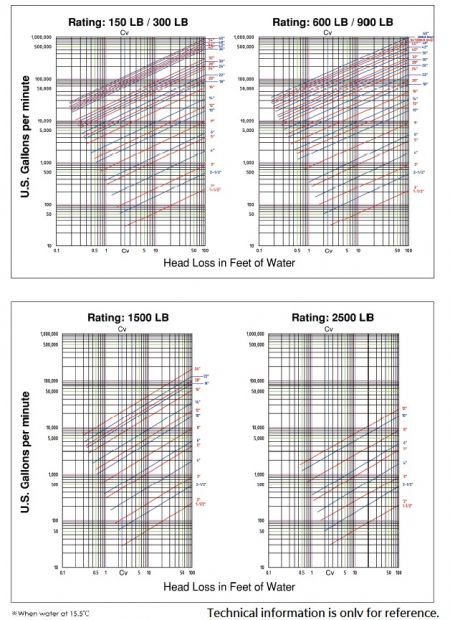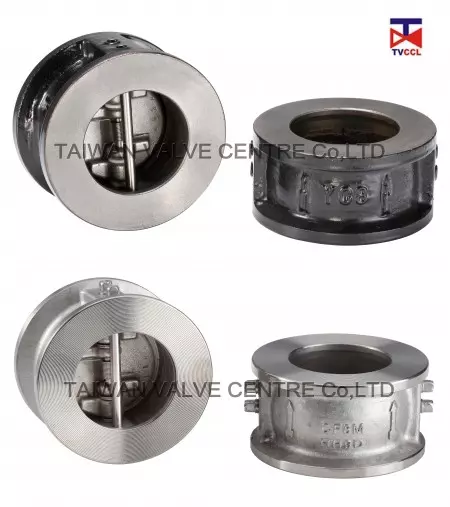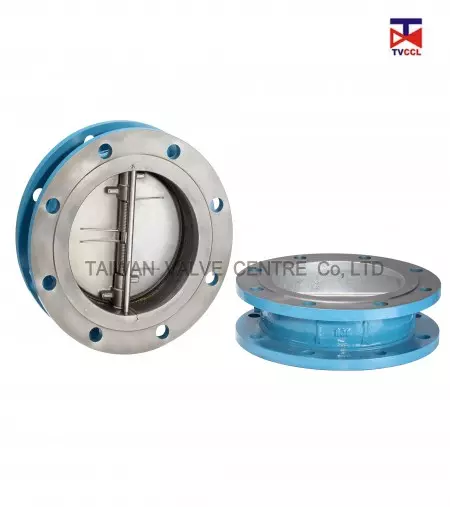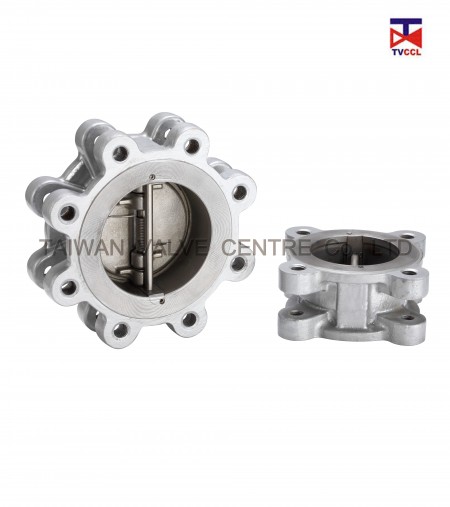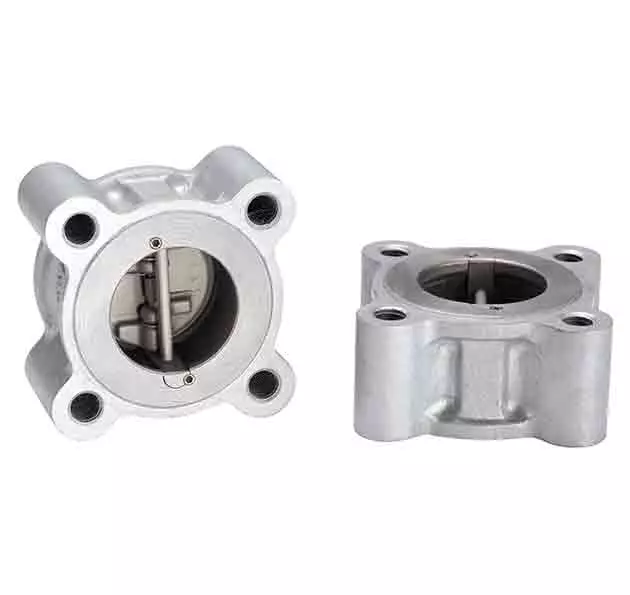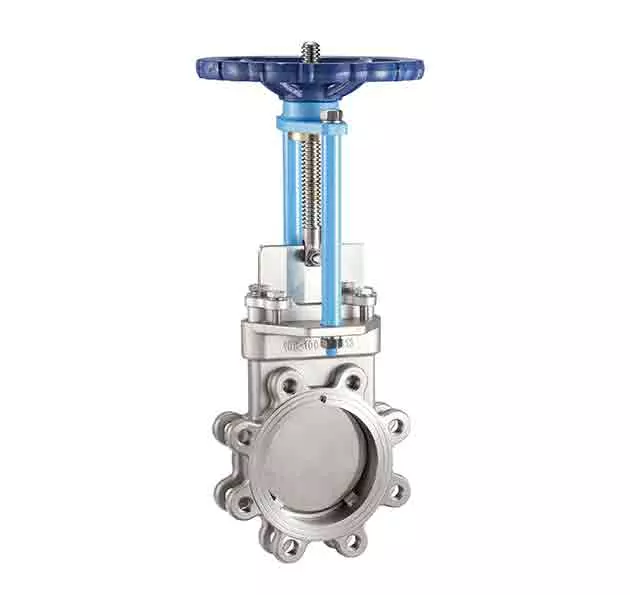Stainless Steel Dual Plate Full Lug Type Check Valve
TC9-CF8.CF8M
CF8.CF8M Solid Lug type dual check valve, CF8.CF8M Wafer Full Lug Check Valve
It is named the Lug type check valve is because the shape is like the ear. Full Lug type dual plate check valve is suitable for the environment where the space is small, because the flange hole has tapping, it can save the space occupied by the nut and the cost of the nut.
Full Lug design dual plate check valves are more popular than swing check valves because they have a low slamming effect.
The advantages of a dual plate full lug type check valve compared to a swing check valve are not limited to space saving and lower slamming rate. The total cost of a dual plate full lug type check valve including the sum of initial cost, maintenance cost, and energy cost, is less than a swing check valve.
Full Lug design dual plate check valves are automatic valves that open with forward flow and close against reverse flow.
Lug type valves are provided with threaded bolting holes in accordance with API 594,ASTM,JIS,ISO
Full lug type has bolt holes to connect with pipe flanges. Because it has threaded bolts around the entire area, the lug valve is a safer option
Solid Lug type valves cover the bolting the entire length of the body.
Features
- Full Lug design, mount between flanges by bolt which through body of valve.
- Do not have install problem of pipe flange, expecially for small size soild lug check valve.
- Retail acceptable.
- Beautifully packaged.
- Customized special valve.
Dual Plate Check Valve Installation Guide:
When installing a check valve, it can be used in both indoor and outdoor environments. However, if the medium is corrosive or the surroundings are prone to rust, it is essential to select a valve material combination that matches the conditions to ensure durability and safety. For special operating conditions, it is recommended to consult TVCCL’s technical team for professional advice.
Before installation, all debris, oxidation scale, and solid impurities inside the pipeline should be thoroughly removed to prevent interference with the valve’s operation. During installation, the flow direction of the medium must align with the arrow marked on the valve body. The piping should be aligned at the front and rear centers, with flange interfaces kept parallel and bolts evenly tightened. Special attention should be paid to the distance between the check valve and the pump, which should be six to eight times the valve size to ensure stable system performance.
For routine maintenance, regular inspections should be conducted to check for leakage, abnormal noise, or vibration. In addition, the valve should be periodically examined for signs of corrosion, jamming, or other irregularities. Necessary cleaning, dust removal, and residue treatment should be performed to maintain proper equipment operation and extend its service life.
Specification
- Size: 1.5" ~ 60" (DN40 - DN1500)
- Pressure Rating For ASME: 125# ~ 2500# Suit For ASME / MSS / API Flange
- Pressure Rating For ISO: PN10~PN40 Suit For ISO Flange
- Pressure Rating For JIS: 5K ~ 20K Suit For JIS Flange
- Material:WCB,CF8,CF8M,ALBC3,A8904A(MOQ)
- Designed in accordance with API 594.
- End Connection: Wafer (TC1), Lugged (TC6, TC9), Flanged (TC4)
- (Other flange connection please contact Taiwan Valves Centre Co., Ld.)
- *Technical information is only for reference. Taiwan Valves Centre Co., Ltd. reserves the right to change without previous notice.
SELECTION GUIDE
1. Clarify Application Requirements and System Conditions
Begin by thoroughly assessing the environment in which the valve will operate. Key considerations include:
• Type of fluid — Is the medium water, oil, gas, slurry, or a corrosive chemical?
• Operating parameters — What are the system’s maximum pressure and temperature?
• Flow behavior — Is there a risk of sudden flow reversal or water hammer?
• Space limitations — Is the piping layout compact or spacious?
These factors help identify the most suitable valve materials and configurations for your system.
2. Select Materials Based on Fluid and Environment
The valve’s body and internal components must withstand corrosion and wear caused by both the fluid and the surrounding conditions. Common material choices include:
• Stainless steel — Excellent for corrosive or sanitary applications.
• Carbon steel or cast iron — Suitable for general-purpose use with non-aggressive media.
• PVC or engineered polymers — Ideal for low-pressure, non-corrosive systems.
Avoid incompatible combinations—such as using brass or mild steel with aggressive chemicals—as this may result in premature failure.
3. Choose the Correct Size and Pressure Rating
Valve sizing should align with the pipe diameter and expected flow rate:
• Proper sizing minimizes pressure drop and prevents turbulence.
• Ensure the valve’s pressure and temperature ratings exceed system requirements to maintain safety and reliability.
4. Evaluate Valve Dynamics and Performance Characteristics
Different wafer check valve designs offer distinct advantages depending on system demands:
• Spring-loaded or dual-plate wafer valves — Provide quick, silent closure to prevent water hammer in high-cycle operations.
• Standard single-plate models — Adequate for slow, steady flow in simpler systems
Seat Material Options for Dual Plate Check Valves
The seat of a dual plate check valve is available in a wide range of materials to meet various media properties, temperature ranges, and pressure conditions. Selecting the right seat material is essential to ensure reliable sealing performance, extended service life, and stable system operation.
Soft Seat Options:
Soft-seated designs provide excellent sealing performance and are typically made from rubber materials such as EPDM, NBR, or FKM (Viton®).
EPDM – Ideal for cooling water, potable water, and general water treatment applications.
NBR – Suitable for oils, air, and other neutral media.
FKM (Viton) – Offers superior resistance to high temperatures and aggressive chemicals, making it ideal for chemical and petrochemical industries.
Metal Seat Options:
For high-temperature, high-pressure, or abrasive conditions, metal seats are recommended to ensure enhanced durability and wear resistance.
Metal seats can be manufactured from the same material as the valve body or from stainless steels such as SS304, SS316, SS410, or hard alloys like Stellite 6. The allowable leakage rate for metal seats varies depending on valve size.
For any special rubber material requirements, please feel free to contact us.

HEAD LOSS
Head loss refers to the loss of a fluid’s total energy (or pressure) as it flows through pipelines or valves, caused by factors such as friction, turbulence, changes in flow direction, and resistance within the flow path. In a dual-plate check valve, head loss is the pressure drop that occurs when the fluid passes through the valve plates and internal structure.
The smaller the head loss, the lower the resistance the fluid encounters when passing through the valve, the higher the flow efficiency, and the less energy is dissipated. This reduces the system’s pumping energy consumption and improves overall operational efficiency. Conversely, larger head loss indicates greater flow resistance and requires the pump to expend more power to maintain the desired flow rate. Therefore, analyzing head loss data is an important step in valve selection to ensure system efficiency, pressure control, and economic performance.
Dual Plate Wafer Type Check Valve Operation
When fluid flows in the forward direction, the pressure of the medium pushes the two plates open around the hinge pin, allowing smooth passage with minimal resistance. As the flow velocity decreases, the torsion springs automatically begin to act, gently returning the plates toward the body seats. This design minimizes the distance and time required for closure.
When flow reversal occurs, the plates are already near the seat, enabling the valve to close quickly and securely. This rapid dynamic response significantly reduces the water hammer effect, ensuring quiet, non-slam performance and protecting the system from pressure shock and vibration.
Advantages of Dual Plate Check Valves
Dual plate check valves offer several advantages that make them ideal for modern piping systems. Their compact and lightweight wafer design allows easy installation between flanges, saving both space and weight. The two spring-loaded plates close rapidly when flow decreases, effectively preventing backflow and minimizing water hammer.
Because of their simple structure and few internal components, dual plate check valves require minimal maintenance and provide reliable automatic operation without external power or manual control. They are available in a variety of materials and configurations, making them suitable for water treatment, HVAC, marine, power generation, and industrial fluid systems.
Functions of Dual Plate Check Valves
The primary function of a dual plate check valve is to prevent backflow and ensure that fluid flows in one direction only. Its two spring-loaded plates respond quickly to changes in flow, closing rapidly when flow reversal occurs to protect pumps, compressors, and other equipment from damage.
In addition to backflow prevention, dual plate check valves help maintain system pressure stability, minimize water hammer through non-slam operation, and improve overall energy efficiency. Their compact wafer-type design allows for easy installation and reliable performance across water treatment, HVAC, marine, power generation, and industrial pipeline systems.

Applications
- Dual plate Full Lug type check valve is suitable for high temperature and high pressure environment, like Petrochemical, Refinery or power plant.
- Applied in Water Supply Systems, Fire Water Systems, Cooling Water, Chilled / Hot Water Systems, Boiler Feed Water, Sea Water, Potable Water, Raw Water etc.
- Suitable for gas, like LPG, LNG, Sour Gas Low Temperature, Cryogenic Applications
- Used in pharmaceutical, Power and other industries
- Solid lug type dual check valve can use for liquids and gasses in general services, on-/offshore applications, etc.
- In Nuclear Industry, Dual Check Valve used for feed water control system, make-up water or other.
- Also use in steam, oil, nitric acid, acetic acid, strong oxidizing medium and urea, different medium should chose different material.
More Knowledge about TVCCL valve:
TVCCL Full Lug type valve has lugs that are used to mount the valve to lugs that are attached the flanges on the ends of sections of pipe so that each length of pipe can be removed and replaced independently. Full Lug Type check Valve have the main advantage is you can disconnect any flange of the pipeline. Full Lug type check valves require different connections depending on the environment and area. TVCCL check valve has many choices of connections, generally wafer, flange and lug. Among them, the lug type is divided into two types, generally lug type check valve (TC6) and full lug type check valve (TC9).
The difference between the two is that the Lug type flange is hollow at the flange, so the weight is lighter; the full lug type check valve is solid to the flange, so the weight is heavier, but it is also stronger. Full Lug type check valves are also connected by flanges on both sides, so there is no flange thickness. For Full Lug type check valves, the flange thickness is equal to the face to face (FTF).
More Knowledge about dual plate check valve:
CF8.CF8M - literally, "stainless steel" is the steel rusty hardly. Stainless steel is used where both the properties of steel and corrosion resistance are required.
Stainless Steel are devided into many serials. Most commonly are A351 CF8,A351 CF8M,A351 CF3M…etc.
Solid Lug Type check valve also called Full Lug type check valve. It is named the Lug type is because the shape is like the ear. Full Lug type is suitable for the environment where the space is small, because the flange hole has tapping, it can save the space occupied by the nut and the cost of the nut. Full Lug check valve has the same advantages and installation with Lug type, just the shape is different. Full Lug type Check valve is threaded (Flange holes by tapping). Also, after tapping the holes, it only needs the bolt to install, it can decrease the spent of Nuts on the contrary. Clamped between flanges with bolting passing through the body of a valve. The full lug type wafer type check valve's design that one end of the line can be taken off without having an effect on the opposing side. This can be executed by using flanges, along with two sets of lugs (bolts) that don't utilize nuts since each flange features its own bolts. It's also important to note that you don't need to shut down the entire system in order to clean, inspect, repair, or replace a lug wafer valve.
- Related Products
Dual Plate Wafer Type Check Valve
TC0
Fast Delivery: Most orders are shipped within 3-7 days, depending on stock availability. Versatile...
DetailsDual Plate Flange Type Check Valve
TC4
Simplified Installation with Flange Type Design Unlike lug type check valves, flange type double...
DetailsDual Plate Lug Type Check Valve
TC6
Lug type double disc check valves typically feature multiple threaded bolt holes around the valve...
Details- Files Download
Dual Plate Wafer Style Check Valve Installation and Maintenance Instructions
Installation and Maintenance Instructions for dual plate check valve
Download- FAQ
Q.What Is Check Valve?
TVCCL Check Valve is a dual plate check valve that conforms to API 594. TVCCL is known as one of the leading manufacturers of Valve in Taiwan since we established.A...
Q. How Do Install Double Disc Check Valve In Pipe?
Taiwan Valve Centre Co.,Ltd. is the professional dual check valve manufacturers in the Taiwan. This information concerning the installation and operation...
Q. What Kind Of Material TVCCL Stock For Dual Check Valve?
Materials Stocked for Dual Plate Check Valve by TVCCLTVCCL, a pioneer in valve manufacturing, has been at the forefront of the industry since 1998. Our expertise...
Stainless Steel Dual Plate Full Lug Type Check Valve - CF8.CF8M Solid Lug type dual check valve, CF8.CF8M Wafer Full Lug Check Valve | Made in Taiwan Dual Plate Check Valves Manufacturer | Taiwan Valve Centre Co., Ltd.
Located in Taiwan since 1998, Taiwan Valve Centre Co., Ltd. has been a dual plate check valve manufacturer with all the valves sold to 1,500 clients in 80 countries worldwide. Their main valve products, including Stainless Steel Dual Plate Full Lug Type Check Valve, dual plate check valves, dual plate full lining type, retainerless check valves, bypass check valves, short and long wafer check valves and spring wafer type for industries, such as oil, shipbuilding, seawater desalination, cooling system and nuclear.
TVCCL has a competitive pricing, reliable quality product and excellent after-sales support, well-down packing. We have received good reputation as being a well-known supplier in supplying reliable quality and competitive price check valves from customers. 20 years of experiences in producing dual plate check valve, excellent after-sales support, OEM / ODM, oil industry, shipbuilding, seawater desalination, cooling system, nuclear industry.
TVCCL, TAIWAN VALVE has been offering customers high-quality and durable industrial check valves for any applications since 1998, both with advanced technology and 25 years of experience, TVCCL, TAIWAN VALVE ensures each customer's demands are met.

